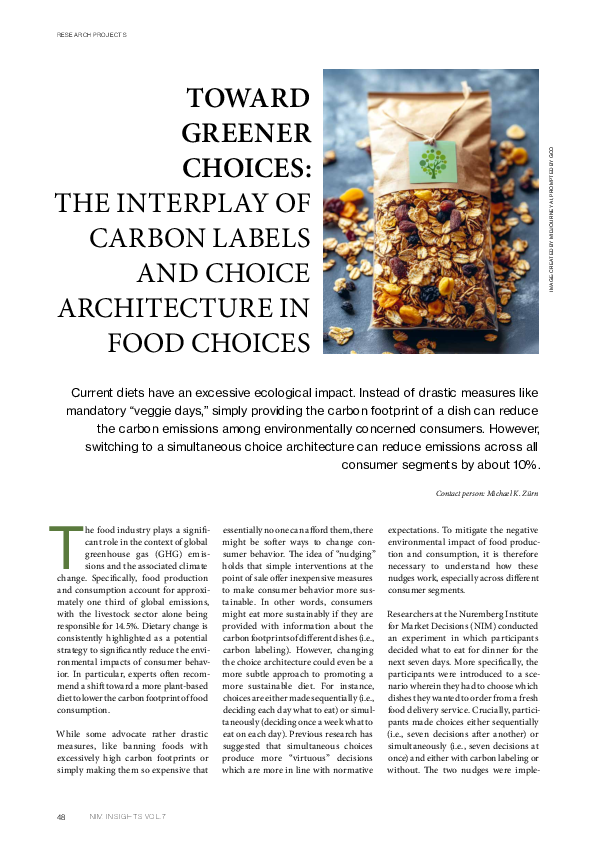Forschung
Toward Greener Choices

IMAGE: CREATED BY MIDJOURNEY AI, PROMPTED BY GCO
Current diets have an excessive ecological impact. Instead of drastic measures like mandatory “veggie days,” simply providing the carbon footprint of a dish can reduce the carbon emissions among environmentally concerned consumers. However, switching to a simultaneous choice architecture can reduce emissions across all consumer segments by about 10%.
The food industry plays a significant role in the context of global greenhouse gas (GHG) emissions and the associated climate change. Specifically, food production and consumption account for approximately one third of global emissions, with the livestock sector alone being responsible for 14.5%. Dietary change is consistently highlighted as a potential strategy to significantly reduce the environmental impacts of consumer behavior. In particular, experts often recommend a shift toward a more plant-based diet to lower the carbon footprint of food consumption.
While some advocate rather drastic measures, like banning foods with excessively high carbon footprints or simply making them so expensive that essentially no one can afford them, there might be softer ways to change consumer behavior. The idea of “nudging” holds that simple interventions at the point of sale offer inexpensive measures to make consumer behavior more sustainable. In other words, consumers might eat more sustainably if they are provided with information about the carbon footprints of different dishes (i.e., carbon labeling). However, changing the choice architecture could even be a more subtle approach to promoting a more sustainable diet. For instance, choices are either made sequentially (i.e., deciding each day what to eat) or simultaneously (deciding once a week what to eat on each day). Previous research has suggested that simultaneous choices produce more “virtuous” decisions which are more in line with normative expectations. To mitigate the negative environmental impact of food production and consumption, it is therefore necessary to understand how these nudges work, especially across different consumer segments.
Researchers at the Nuremberg Institute for Market Decisions (NIM) conducted an experiment in which participants decided what to eat for dinner for the next seven days. More specifically, the participants were introduced to a scenario wherein they had to choose which dishes they wanted to order from a fresh food delivery service. Crucially, participants made choices either sequentially (i.e., seven decisions after another) or simultaneously (i.e., seven decisions at once) and either with carbon labeling or without. The two nudges were implemented orthogonally—that is, either none of the nudges, one of the nudges, or both nudges were integrated into the decision.
Both Nudges Can Reduce the Carbon Footprint of Food Consumption by 10%
The results show that simultaneous choice and carbon labeling effectively reduce the carbon footprint of food consumption. Both nudges reduced the average carbon footprint by about 10%. However, while carbon labeling only took full effect in consumers who already valued environmental protection, simultaneous choices were effective across consumer segments. In other words, the effects of changing the choice architecture seem to be less contingent on the environmental attitudes of consumers than the effects of providing information. Furthermore, our results neither suggest significant cannibalization effects nor synergies between both nudges. Therefore, both interventions could in principle be applied in tandem to realize simultaneous boosts in sustainable consumption.
CARBON FOOTPRINTS:
A carbon footprint measures the total greenhouse gas emissions, primarily carbon dioxide, generated by an individual, organization, or product. Managing and reducing the environmental impact of operations, supply chains, and energy use is key to meeting sustainability goals, complying with regulations, and enhancing corporate reputation in a climate-conscious market.
CHOICE ARCHITECTURE:
Choice architecture refers to the way options are presented to influence decision-making. In the context of business, it shapes customer behavior, employee choices, and strategic outcomes through design, defaults, and incentives. An effective choice architecture can drive better engagement, productivity, and ethical decision-making.
Carbon Labeling and Simultaneous Choice in Practice
In this project, simultaneous decision-making and carbon labeling were exemplarily applied to food choices, but the results may be applicable to other sectors, such as fashion and clothing, holiday planning, or transport.
Carbon Labeling
In principle, carbon labels can be applied to a wide variety of choice options. Through such application, consumers can make more informed and—if they care enough about protecting our ecosystem—more sustainable choices by reducing their carbon footprint. To be sure, gathering information about specific carbon footprints remains a challenge, but recent advances in process mining and machine learning might soon provide more accurate information at a fraction of the cost. At the same time, the mere communication of a carbon footprint is often practically costless (especially if decisions are made in the digital domain), as it only requires the provision of additional information at the point of sale. However, the NIM research project “How do carbon footprints affect our decisions?” underscores the importance of evaluability—that is, consumers must be able to adequately understand the information. Specifically, consumers need to have a reference point to compare the carbon footprint of a particular choice option and thereby decide whether it is high or low. In choice settings exhibiting a joint evaluation of the options (as in the current experiment), evaluability is established by comparing the carbon footprint of each option with the footprint of the other options. But if options are evaluated separately, retailers and producers should provide external reference points, such as in the form of average footprints across different options or the footprint of a standard option.
Simultaneous Choice
There are several settings in which choice architectures could be altered to allow for simultaneous instead of sequential choices. In particular, consumers often inevitably stick to the same retailer for several consumption decisions—for instance, if they chose a subscription (e.g., delivery services) or if there simply only is a single provider available (e.g., company canteens). In such cases, retailers can encourage their customers to make several decisions in bulk either by offering discounts for bulk purchases or just by highlighting the convenience of not having to make a new decision on each occasion. Of course, it is not always possible to create environments for simultaneous decision-making, but focusing on settings where such a choice architecture can already be implemented with reasonable adjustments will contribute to more sustainable consumption decisions. To a certain degree, making consumers aware that a decision will come up repeatedly may suffice to nudge them into a mindset resembling simultaneous choice. In addition, supporting consumers to engage in meal planning may also prompt more sustainable food choices
KEY INSIGHTS
Carbon labels can be an effective and often cheap way to promote more sustainable consumption decisions.
Simultaneous choices are more sustainable than sequential choices.
Carbon labeling and simultaneous choice operate independently of each other and can therefore be employed separately or in combination.
While carbon labeling is most effective only for people with higher levels of ecological concern, simultaneous choice leads to more sustainable decisions across customer segments.
Even though the nudges were tested with food choices, they may also be successfully applied in other domains.
Projektteam
- Dr. Michael K. Zürn, Senior Researcher, NIM, michael.zuern@nim.org
Kontakt

